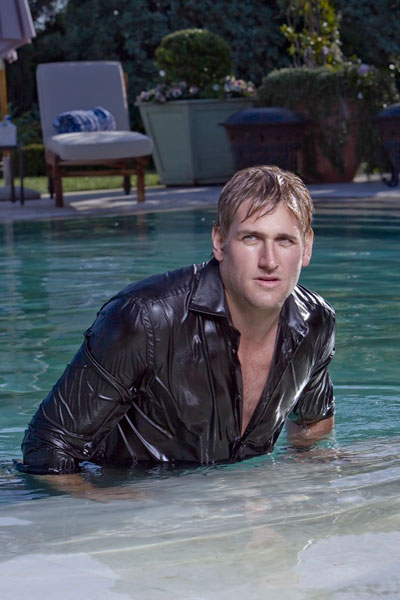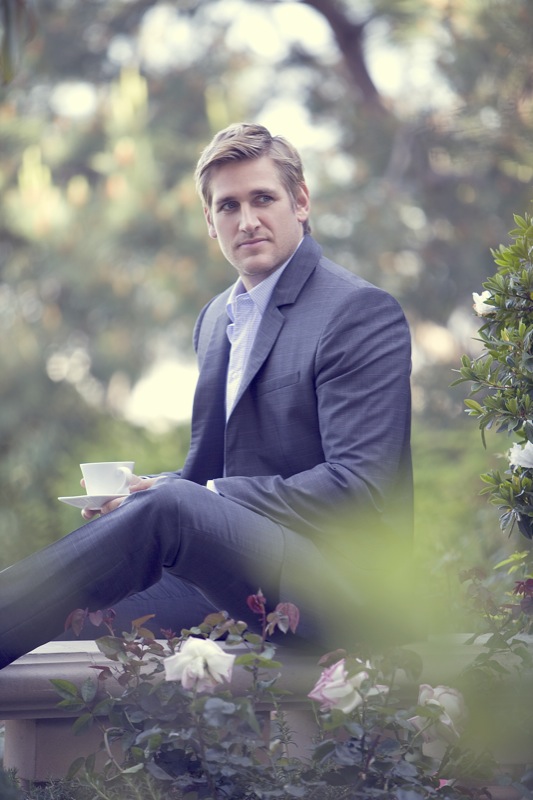Curtis Stone a name synonymous with phrases like Master Chef, pop culture icon, restauranteur and lately his proudest titles of father and husband is also to BHL Media a part of a proud history. Curtis Stone 10 years ago was the first male cover that we had ever had. Deciding to put a male on the cover was a decision we did not want to take lightly. We wanted someone that we knew could be as celebrated in 10 years and guess what we were absolutely right in choosing Curtis.

Reading his first article which was written in February of 2011 we are impressed with how his life has changed for the better because of his hard work, resilience and dedication to improving himself in every aspect of his life. Mark Kurian, our President and Co-Founder has always had a very special place within the BHL family for Curtis. He states “Curtis is a man of humility, talent, dedication and is a man of hard work and someone we(BHL) will always be proud to say was our first male cover.”
Over the last 10 years, Curtis’ life has changed in some pretty dramatic and beautiful ways. His perspective of things has grown and evolved. His achievements have constantly grown and his life is different but the core of the man, that is Curtis Stone has not changed. We asked Curtis some questions and were surprised by some of the answers but also even more proud today to say he was and will forever hold a piece of BHL history. Here was the conversation with Curtis and the original article the cemented him into the BHL family.
BHL: It’s been 11 years since we interviewed you, what are the biggest changes since we did the first interview?
Curtis: Wow, just about everything has changed in the past eleven years. I’m married now with two sons and have a couple of restaurants. I opened Maude in Beverly Hills back in 2014. Named after my paternal grandmother who first inspired me in the kitchen, it was my dream little restaurant with 24 seats and a tasting menu. We opened changing the menu monthly, focusing on a seasonal ingredient. So you may get peaches in the summer and chicories in a winter month. We did that for four years and realized that the wine pairings had become an integral part of the experience. We never wanted to repeat a dish or ingredient, so we shifted gears and changed the concept to a quarterly menu driven by the team’s travels to a different wine region of the world. In the summer of 2016, I opened Gwen Butcher Shop & Restaurant in Hollywood with my brother, Luke, as my business partner. Both of us worked in a butcher shop back in Australia and our grannie, Gwen, lived on a farm in Victoria. The meat-driven menu and live fire cooking really drives the dining experience there. Two years later, we opened a similar concept with Georgie by Curtis Stone in Dallas. I also have a line of kitchenware that I’ve developed, taking what I’ve learned in professional kitchens and creating tools to improve the cooking experience for home cooks. It is all fun and keeps me fairly busy. I am very lucky.

BHL: What has surprised you about the restaurant industry and the changes in the last few years?
Curtis: Well, the pandemic has shaken everything up so my answer may have been different a year ago. I’ll tell you what hasn’t surprised me – the tenacity of the industry. Restaurants have taken a massive hit over the last year, but chefs know how to take a beating. We cut and burn ourselves; are on our feet for long hours. Now of that is new but the pandemic has forced us to stay creative and nimble during these challenging times and band together. The term “in the weeds” has been an understatement but we’re all making our way through it.
BHL: How did you decide to open in Dallas?
Curtis: Dallas is a meat lovers city, so it seemed like a no brainer to emulate the Gwen concept with Georgie. Georgie has its own butcher shop and its own style but shares what we call “primal elegance” with its Hollywood counterpart.
BHL: What’s been your favorite TV show or appearance?
Curtis: I’ve had the good fortune to do a lot of television. I’m working on Season 3 of Field Trip with Curtis Stone, traveling to get inspiration from different parts of the world to bring back to the restaurants. Travel and eating foods from other cultures is a part of any chef’s education and it’s never-ending so when you can combine the two, it’s always a win.

BHL: What’s your favorite dish to make for those you love?
Curtis: Truth be told, I love grilling a good steak over an open flame. That with some seasonal veg and a big salad makes a perfect meal.
BHL: What’s your favorite foodie city?
Curtis: I’d have to say that my adopted home of Los Angeles is my favorite foodie city at the moment. LA has really come into its own over the course of the last decade. Often overshadowed by New York and San Francisco in the U.S., LA has just about everything I love to eat – spicy Thai, taco trucks, incredible sushi, and elegant fine dining. Though I’m happy the city is finally getting long overdue recognition. It’s also been an inspiration to see how my fellow chefs here have pivoted and tapped into their creativity during the pandemic.
BHL: Tell us about the Butcher Shop?
Curtis: The butcher shop at Gwen is the heartbeat of the restaurant. The counter is right at the entrance so when you walk through the doors, you immediately know what Gwen is about. The shop is very chef-driven, with the most premium meats we can get our hands on. While we import wagyu from Australia and Scottish game birds, sustainability is very important to us and the butchers have relationships with our purveyors, visiting ranches to ensure that the animals are being raised ethically. To that end, our in-house charcuterie program ensures we are using the whole animal making terrines, pates, and whole muscle cures. My dream was to have an old world European butcher shop in the middle of Los Angeles where the butchers know our customers. It really is quite special.
BHL: What’s your favorite kitchen appliance?
Curtis: Every chef has to have a good knife but on the appliance front, I’m really loving induction cooking. I’ve been moving away from gas ranges at the restaurants and bringing in induction burners. They’re consistent, energy-efficient and the new wave of appliances.
BHL: What other career did you ever dream about having?
Curtis: I love boxing. It’s how I choose to workout. I’ll get together with mates to watch a big fight. Yeah, there’s a secret part of me that would love to be a boxer.
BHL: How has becoming a father changed your life?
Curtis: Firstly, you no longer put yourself first but also it gives you someone else to work hard for. I want to show my boys by example that hard work pays off. There is no resting on your laurels; you get out of it what you put into it.
BHL: Who is your favorite chef?
Curtis: Marco Pierre White who I worked with for eight years in London will always be my first professional culinary inspiration but I’m also a huge fan of Ben Shewry from Attica in Melbourne. He is an incredible chef, works tirelessly to preserve the Aboriginal heritage of Australia, and is just an all-round nice guy.
BHL: What’s your favorite restaurant other than your own?
Curtis: That’s a tough one because I love to eat. I really like Omakase at Sushi Park in West Hollywood. It’s in a strip mall, completely low key but amazing. In fact, I took Ben Shewry there when he was in town!

Original Article
By G. James Daichendt
Photography by Michael Stonis
Assisted by Rod Foster and Connor Stewart
Grooming by Helen Robertson/Celestine for SAMPAR Paris
Styling by Toni Ferrara | Assisted by Nicole Velasquez
Bloodied and bruised, he climbed the stairs back to the kitchen so he would not fall behind as the orders stacked up. The gritty reality of the fast-paced restaurant industry that saw Curtis Stone falling down a flight of stairs while rushing between shifts directly coincides with Stone’s fierce competiveness. His humble start, quick progression, and eventual stardom are apt for a sports metaphor. Like the ball player who made it to the pros, Curtis has paid his dues and is now playing on a different level.
We catch up with Curtis poolside at an enormous Beverly Hills mansion for our photo shoot—perhaps are presentation of his life these days. While the camera crew sets up for the upcoming water shot, Curtis opens up about his motivations, cooking culture, and the advent of the celebrity chef.

The boom in restaurant sales and the corresponding foodie craze has turned America upside-down in recent years. Gourmet food trucks, an explosion of cookbook publications, and a long list of celebrity chefs instructing, competing, and vying for the attention of viewers have transformed television and the way Americans experience food.
And Chef Curtis Stone is right in the middle of this cultural revolution. A regular on television programs like The Biggest Loser, star of the breakout hit Take Home Chef, and an investor and judge on America’s Next Great Restaurant, he is now hosting season three of Bravo’s Top Chef Masters. With a dizzying schedule that resembles a concert tour, the chef carries some guilt for the image he embodies. Being a chef after all is a difficult job and one that requires years of training and hard work, something the camera and photo shoots tend to gloss over and present in a neatly framed package.

Unfortunately, the cult of celebrity has garnered unrealistic expectations—a situation viewers enjoy as many cooking shows feature Survivor type competitions with someone eliminated each episode. To be a great chef requires a commitment to food. When asked how he learned to cut onions, he references thousands of hours on the cutting board. This is not something one picks up with a simple technique but only through hard work–something Curtis learned at an early age.
Curtis remembers these times well, and the painful and grueling aspects are not tough to drag out of him. In what Curtis describes as a “pivotal decision,” the young Aussie desperately volunteered to work for free in order to cook with the highly regarded Marco Pierre White in London. White is a perfectionist with impeccable standards and Curtis long admired the revered chef. The decision paid off, as he began right away at The Grill Room at Café Royal. With a sly grin, Curtisdescribes the atmosphere as “a place where if you didn’t get fired that day then you did a good job.”

The progression of Curtis’ chef career over eight years under White saw a number of highlights: a rise in responsibilities, a Michelin star, and eventually the position of head chef at Marco’s critically acclaimed flagship restaurant, Quo Vadis. He even played a significant part in building a cookbook for White. The trials of collecting awards and competing for recognition within a world that is full of long hours, weekends, and injury is demanding and stressful. Miles from the television studio, a typical day is much more akin to physical labor as one strives for perfection in the kitchen.
These beginnings were steeped in learning and mastering the art of fine cuisine, a craft that’s been lost in today’s fast paced culture according to Curtis: “Fifteen years ago food was at its fanciest…nowadays it’s farm to table and you splash it on a plate.” This insight is why we want to watch Curtis cook and provide feedback to aspiring chefs.
At any time of the day, one can watch a cooking demonstration on television. Often these programs opt for the quick and easy solution that can be reproduced at home in a relatively short format. This paradigm is a symptom of the modern family that view the long hours of food preparation as a pragmatic expenditure in exchange for ready-made meals. The realistic expectations can be recreated while the longer gourmet demonstrations are an extension and an invitation to dine out.
These cultural shifts did not happen overnight. Curtis believes there have been some significant changes in the United States that elevated cooking shows into the wildly popular paradigm that they have become. Over the past few generations the make-up of the family has changed. Households are busier and less traditional.As a result of these changes, there are less folks committed to the art of cooking. Households run by a single parent or two working parents who find it difficult to balance the time needed to prepare a traditional meal.
The television programs featuring chefs or the process of cooking fill this void. It is an olive branch for the traditions lost, and the popularity certainly speaks to our cultural condition as hungry Americans. We desire it for entertainment and for the lost experiences of eating together. It’s a connection to the ritual of preparing and enjoying food as a community. Even if it’s just you and the TV.
The process of enjoying food is offered symbolically as the viewer watches everything from the initial conceptualizing, the selection of the proper ingredients, the exciting and mouth-watering cooking, and the eventual enjoyment of the food. In fact, the host actually samples the food and attempts to express and explain how it tastes. The virtual experience is far from perfect,much like a super model choosing to do talk radio. But the visuals do get the taste buds flowing. These aspects are made physical when a cookbook (of which Curtis has several) is bought and the experience is replicated at home. It’s a tempting experience that Curtis recently engaged as he sought to bake hot cross buns. Overwhelmed by the visuals from his research, he became so hungry that he rushed out for tacos down the street.

Over the last decade, restaurant sales have increased over 50 percent and the subscriptions to the Food Network have jumped through the roof. A history that started with Julia Child and her television program The French Chef and continued through to Emeril Lagasse now moves onto a younger generation represented by Curtis Stone. It’s a phenomenon that shows no sign of slowing down.
Yet not all chefs are created equal, and Curtis divides these folks into bakers and cooks. Good bakers “like to follow instructions and follow them very carefully.” They are organized and need structure in order to achieve their desired outcomes. You might hear a baker say something like: “You can’t just throw some raisins into a mix because you love them; it changes the way the dough rises and ultimately ruins the recipe.”

In contrast, good cooks are able to be much more creative in the kitchen, and in the case of Curtis, he prefers to let the seasons influence the way he cooks. Preferring to use ingredients that are fresh and available, he changes the ingredients based upon what is fresh and available. He sees no reason to start with ingredients that are subpar. This is a characteristic that a good baker does not have the luxury of doing. Curtis humorously acknowledges that the disadvantage of a creative cook is “messy bedrooms and bloody disorganized lives.”
Clearly, cooking food is a performance for Curtis, a ritual that begins the moment the decision to cook takes place. From the time one enters a home, the smells overcome the entry way and the chef plays a central part in this experience. There is a kinship and empathy that the viewer feels with Curtis Stone in the kitchen and on the small screen. The connection comes through whether it’s a competitive context or when he is modeling proper eating habits. This is an important and much needed process, an experience that begins when the television is turned on and complete when we finally eat something.


